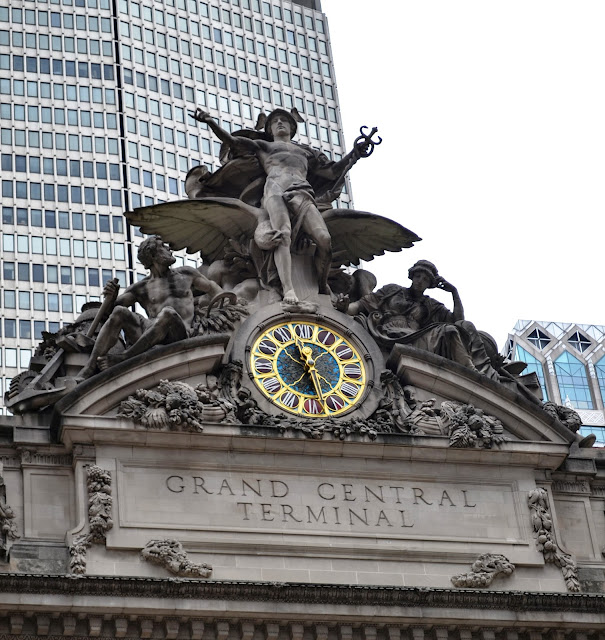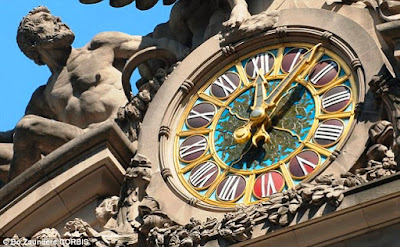 |
| photo by Mj |
Included in the architects' design was a monumental sculptural grouping and clock. Rising above the uppermost cornice, it would serve as the crowning touch to the sumptuous structure.
 |
| A postcard, depicting the proposed terminal, made a stab in the dark at the possible clock and sculpture. |
Paris sculptor Jules-Felix Coutan had won the commission for the group. Coutan was well-chosen for the Beaux-Arts style work. He had recently completed the sculpture France of the Renaissance for the exuberant Alexander III Bridge in Paris.
When the new Grand Central opened, Coutan was still at work in his Paris studio on the group entitled Transportation. His finished model, one-quarter sized, finally arrived at the stone yards of William Bradley & Son in Long Island City over a year later, in May 1914. There the architectural sculpture firm of John Donnelly set to work recreating the limestone figures in full size. Among the firm's sculptors working on the project was Oliver N. Burdett, whose work also appears on significant buildings like the Morgan Library and New York Public Library.
The massive scale of the grouping, touted by The New York Times on June 14, 1914 as "World's Largest Sculpture Group," required the work to be completed in sections and pieced together. The article explained "The group...is constructed like the front of a building; that is, it is built up in continuous layers of stone cemented together."
The work, 50 feet tall and 60 feet wide, would weigh over 1,000 tons on completion. Designed to embrace the massive clock--crucial to an early 20th century train station--it was surmounted by a figure of Mercury, messenger of the gods as well as the god of travel, speed and commerce.
To his right reclined the figure of Hercules, who symbolized strength. Coutan depicted the god with a less-brawny physique than expected. The Times noted he "is surrounded by objects familiar in daily life. Here are the cogwheel, the anchor, the anvil, and the beehive. Also there are sheaves of wheat, and branches of oak." Coutan's intention was, apparently, to focus less on Hercules' musculature so as to give him a more commercial and domestic focus.
"If the figure of Hercules is indicative of strength and action, that of Minerva, on the other side of the central figure, typifies thought and study," explained the article.
About two weeks before the group's completion, Walter Roberts of William Bradley & Son described the figures to a New York Times journalist. Leading him to a huge unworked block of limestone, he said "This is a head for the lady over there, Minerva. It weighs some fourteen tons. We hope to get out of it also her curls and ornaments. And that block of stone coming down the shop on the overhead crane is a little memorandum, a book or scroll, which she may peruse during the rest of her life."
Mercury was being worked on in two sections. "Up to the waist line we are building him on this side of the shop, and on the other we are taking care of the rest of him."
The Times told its readers "Mercury will stand with right hand extended and holding in his left the magic wand said to exercise influence over living and dead, and to bestow wealth and prosperity." Behind Mercury, an immense eagle spread its wings, extending its rather threatening head around the god's right leg.
 |
| When Grand Central neared completion (and opening) in 1913, Jules-Felix Coutan was still working on the sculpture in Paris. from the collection of the Museum of the City of New York |
John Donnelly and William Bradley & Son completed the monumental task within six weeks of receiving the plaster model. Installed above the Park Avenue entrance, the figures surmounted a broken pediment which embraced the gigantic Tiffany glass-faced clock. At 13 feet in diameter it remains the largest example of Tiffany glass in the world. On either side of the clock, cornucopias spilled sumptuous fruits and grains over the ledge.
Throughout the subsequent decades Transportation became alternatively known as the Glory of Commerce. This is possibly because of one magazine account which identified Hercules as depicting "moral energy," Minerva as "mental energy," and Mercury as "symbolizing the glory of commerce."
The clock, the sculptures and the building itself were threatened several times in the 20th century. In 1954 William Zeckendorf hired architect I. M. Pei to design an proposed 80-story structure on the site. Pei's concept was a somewhat hour-glass shaped skyscraper. And although in 1963 the Pan Am Building replaced the six-story Terminal office building; the main structure survived.
 |
| Grand Central was blackened with dirt by the second half of the century. photo from the collection of the New York Public Library |
Grand Central was designated a New York City monument, saving the building. In 1992 a complete restoration of the soot-blackened building was initiated. Included in the 12-year project was the dismantling and restoration of the Tiffany Glass clock by Rohlf's Stained & Leaded Glass of Mount Vernon, New York.
 |
| photo copyright Bo Zaunders via http://www.dailymail.co.uk/travel/article-2271436/Grand-Central-Stations-100th-anniversary-A-palace-Manhattan.html |
The studio replicated damaged or missing pieces, cleaned the existing elements, and reinstalled the restored clock face. Today, as it was in 1914, the monumental sculptural group and clock are the focal point of one of Manhattan's most recognizable landmarks.
.png)

Thank you for that great description & explanation of the figures around the clock. I'll look at it a bit differently when I pass by it each morning.
ReplyDeleteMight the anchor near Hercules refer to the origins of the Vanderbilt family's transportation empire (beginning with Cornelius Vanderbilt working on his father's ferry in New York Harbor, then starting his own ferry between Staten Island and Manhattan, earning him the nickname Commodore)?
If so, then perhaps the figure of Hercules was meant to be a subtle reference to the Vanderbilts themselves, and their role in building the New York Central railroad and Grand Central Terminal (the beehive representing their industriousness, the cog representing the machinery of the railroad, etc.)?
Do you know why you use the Roman names for the Gods and not Greeks?
ReplyDelete